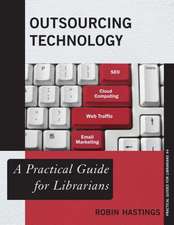FUTURE PROOFING THE NEWS
Autor Kathleen A. Hansen, Nora Paulen Limba Engleză Hardback – 25 ian 2017
Preț: 375.13 lei
Nou
Puncte Express: 563
Preț estimativ în valută:
71.80€ • 74.67$ • 60.08£
71.80€ • 74.67$ • 60.08£
Carte tipărită la comandă
Livrare economică 14-28 martie
Preluare comenzi: 021 569.72.76
Specificații
ISBN-13: 9781442267121
ISBN-10: 1442267127
Pagini: 274
Dimensiuni: 152 x 229 x 24 mm
Greutate: 0.54 kg
Editura: Rowman & Littlefield
ISBN-10: 1442267127
Pagini: 274
Dimensiuni: 152 x 229 x 24 mm
Greutate: 0.54 kg
Editura: Rowman & Littlefield
Cuprins
Preface
Acknowledgements
Chapter One: Who Needs Yesterday¿s News? Losing the News News Users News Preservers Access to Preserved News
Chapter Two: Newspapers The Newspaper Industry Why Newspapers Were Lost How Newspapers Were Preserved Newspaper Preservation Challenges A Newspaper Historian¿s View
Chapter Three: Visual News The Rise of Visual News Why Visual News Was Lost How Visual News Was Preserved Visual News Preservation Challenges Photo Archive Users
Chapter Four: Newsreels The Newsreel Industry Why Newsreels Were Lost How Newsreels Were Preserved Newsreel Preservation Challenges Archival Newsreel Collections An Artist¿s View of Newsreel Archives
Chapter Five: Radio The Radio Industry Why Radio News Was Lost How Radio News Was Preserved Radio News Preservation Challenges A Network of Preservation Heroes
Chapter Six: Television The Television Industry Why Television News Was Lost How Television News Was Preserved Television News Preservation Challenges Television Archive Users
Chapter Seven: The Digital Turn Newspapers News Photography Radio and Television Converting Analog Archives to Digital
Chapter Eight: Digital News Early Videotex Experiments CompuServe and Competitors The World Wide Web Why News on the Web (and Beyond) Was Lost Digital News Preservation Today Dark Alliance Case Study
Chapter Nine: Challenges to News Archive Access Who Has An Archive of the Content I Need? How Can I Get Access to the Archive? Are There Tools That Will Help Me Find Specific Items in the Archive? I¿ve Found What I Need: Will I Be Able to Use It the Way I Intend?
Chapter Ten: What Next? The Current State of News Preservation Archival Challenges and Opportunities Avoiding Historical Amnesia
Extra! Extra! Read More About It
About the Authors
Index
Notă biografică
Descriere
Future-Proofing the News: Preserving the First Draft of History examines the history and technology of news reporting in the U.S. and focuses on the decisions that aided or hindered future access. Changing formats of news delivery, business enterprises, and laws have had profound impacts on the ability to find and learn from records of the past.




























